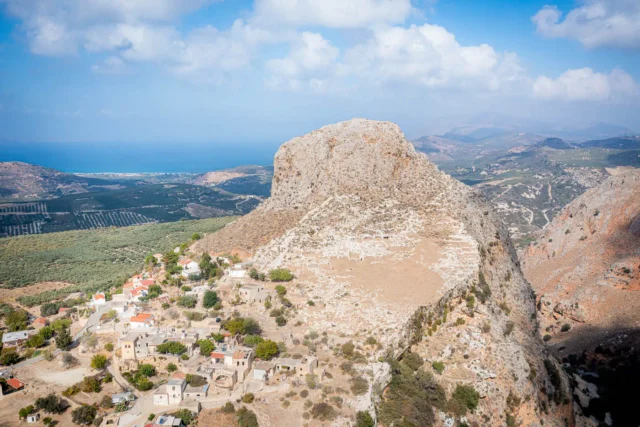Alikianos is a village located in the Platanias municipality of the Chania regional unit, Crete. It lies on the left bank of the Keritis River, at an altitude of 65 meters, approximately 12 kilometers southwest of Chania town, on the road to Lakki. Historically part of the Kydonia province, Alikianos is known for its Venetian heritage, its role in the Cretan uprisings against the Ottomans, and the tragic events it witnessed during World War II.
Historical Overview
Venetian Era: During the Venetian period (1204-1669), Alikianos was a fiefdom of the Da Molin family, who built an imposing mansion with a tower in the village when they settled in Crete in 1229. This mansion serves as the setting for the play “Cretan Weddings” by Spyridon Zambelios, which depicts the suppression of the Kantanoleon Revolt. The village is mentioned in Venetian records as “Alichianu” in 1577 by Francesco Barozzi. The Venetian census of 1583 by Petros Castrofylaka lists it as “Allicanà” with 265 inhabitants. Francesco Basilicata mentions the village as “Allichianù” in 1630.
Ottoman Era: During the Greek War of Independence in 1821, a battle took place in Alikianos between Greek revolutionaries and Ottoman forces. The Egyptian census of 1834 records 40 Christian and 9 Muslim families in the village. In the 1881 census, Alikianos had 507 Greek and 27 Turkish inhabitants and was the seat of a municipality. During the Cretan Revolt of 1897, Alikianos served as a camp for the Greek expeditionary force led by Timoleon Vassos.
World War II: In August 1941, during the German occupation of Crete, German forces executed 118 residents of Alikianos and surrounding villages at the nearby Keritis River bridge in retaliation for their participation in the Cretan resistance. The bridge, built during the Cretan State period and declared a historical monument in 1998, partially collapsed in 2019 due to severe weather.
Modern Era: After Crete’s union with Greece, Alikianos became part of the Kydonia province. In 1940, its name was officially corrected to “Alikianos.” With the Kapodistrias program in 1998, it became part of the Mousouri municipality. Since 2011, it has been a community within the Platanias municipality.
Population Data
Year |
Population |
|---|---|
1900 |
525 |
1928 |
707 |
1940 |
877 |
1951 |
845 |
1961 |
857 |
1971 |
764 |
1981 |
740 |
1991 |
744 |
2001 |
785 |
2011 |
825 |
2021 |
866 |
Points of Interest
- Da Molin Tower: The ruins of the Venetian-era Da Molin tower, built in 1229, are a reminder of the village’s feudal past. According to legend, the tower is haunted due to a gruesome crime that took place during the wedding of the Da Molin’s daughter to the son of the revolutionary Georgios Kantanoleon.
- Keritis River Bridge: A historic three-arched stone bridge built in 1908, declared a historical monument. It was the site of a mass execution by German forces in 1941.
- Church of Agios Georgios: A Byzantine church dating back to the 13th century.
- War Memorial: A monument commemorating the victims of the 1941 execution at the Keritis River bridge.
Village Key Points
- Historical References: Mentioned in Venetian records as early as the 16th century. Associated with the Da Molin family.
- Location: Chania regional unit, Crete, Greece. 12 km southwest of Chania town, on the road to Lakki.
- Altitude: 65 meters above sea level.
- Historical Significance: Historically significant for its Venetian heritage and its role in the Cretan resistance against the Ottomans and the Germans.
- Current Status: A village with a rich history and a growing population.
Access
Alikianos is 11.8 kilometers away from Chania and 1.9 kilometers away from Vatolakkos





















There are no comments yet.